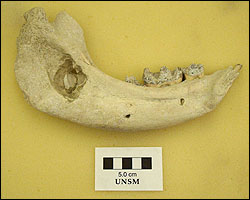Archives
Geologists conclude that even in the Miocene, rhino reigned supreme
By ELLEN GOLDBAUM
Contributing Editor
Lions may get all the good press about being "king of the jungle," but the modern animal that has no predators in the wild, except for man, is the rhinoceros and that probably was the case as long ago as nine million years ago, recent UB research demonstrates.

This jawbone from a baby teleoceras was excavated by a UB research team. A pair of bite marks suggests death by predation.
The researchers came to that conclusion based on their analysis of more than 100 specimens that they excavated during the past two summers from pastureland in northwestern Kansas.
The research was presented last week to scientists at a Geological Society of America meeting (North-Central section) in St. Louis.
Led by William Korth, research assistant professor in the Department of Geology in the College of Arts and Sciences, that excavation revealed bones from juvenile Teleoceras individuals, precursors to the modern rhino.
Studies on these specimens are providing the researchers with information about the Miocene epoch and, in particular, about the lives and habits of this species of rhinoceros, which, the UB scientists say, is closer in body shape to the modern-day hippopotamus.
"We're looking for what the environment was like then and how these creatures lived," said Korth.
The clues lie in the excavation and analysis of the bones and rocks in which they were embedded.
Indeed, the researchers approached the find as though as it were an ancient whodunit.
"We're like the C.S.I. of the Miocene," Korth said.
They could tell that the bones were from very young animals because the ends of the bones were not yet fused.
The researchers first thought they might have uncovered a calving site, where newborns and their mothers were especially vulnerable to predation.
However, they ruled out that possibility because of the absence of bones from the mothers, a finding that confirmed the idea that even 9 million years ago, this ancestor of the modern adult rhinoceros probably had no predators.
"Modern rhinos have no predators because they are very large and fierce, and their horns are a deadly defensive weapon," said Kara Bartley, a master's-degree candidate in the Department of Geology, who is the principal researcher on this work.
That's why, she explained, there is far more mortality today among juvenile rhinos than adults, who die from natural causes or in natural disasters, not from predation.
Based on the kinds of bones found and the types of bite marks on the bones, the geologists now hypothesize that the bones are from individuals who were first preyed upon and then scavenged after death.
"A predation/scavenging scenario would make perfect sense because babies would be easy to ambush and carry away from the mother to another site," said Bartley.
After death, she added, the limbs were probably ripped off by scavengers, which explains the fact that the researchers found heads, backbones and ribs at the site, but very few limbs.
"We're essentially documenting stasis here," said Charles E. Mitchell, professor and chair of the Department of Geology. "These animals were not exactly the same as modern rhinos, but it turns out that the hardships and selection pressures they faced were of the same basic sort we see now.
"This is a case where the more things change, the more they stay the same, and while such findings may not be as emotionally interesting as dramatic changes, they, too, are an important part of the dynamic of evolution," he added.
